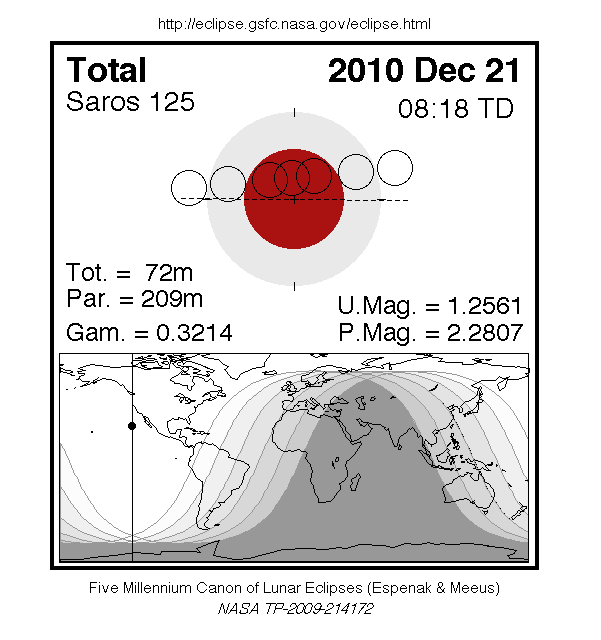Tomorrow night's full lunar eclipse should prove spectacular, should we be fortunate enough to see it. Here's the timeline of the eclipse, both in Universal (Greenwich) Time and Pacific Standard Time. Especially cool is the fact that the maximum eclipse will happen at a longitude of 124° 04' W, about the longitude of Cape Disappointment and the Columbia River bar, and the Olympic Mountains.
Penumbral Eclipse Begins: 05:29:17 UT 21:29:17 PST (9:29:17pm Monday)
Partial Eclipse Begins: 06:32:37 UT 22:32:37 PST (10:32:37pm Monday)
Total Eclipse Begins: 07:40:47 UT 23:40:47 PST (11:40:47pm Monday)
Maximum Eclipse: 08:16:57 UT 00:16:57 PST (12:16:57am Tuesday)
Total Eclipse Ends: 08:53:08 UT 00:53:08 PST (12:53:08am Tuesday)
Partial Eclipse Ends: 10:01:20 UT 02:01:20 PST (2:01:20am Tuesday)
Penumbral Eclipse Ends: 11:04:31 UT 03:04:31 PST (3:04:31am Tuesday)
So, if you happen to be out tide-pooling in Seattle tomorrow evening, if the weather should happen to cooperate (it doesn't look promising) you'll have an amazing eclipse to look for octopi and sea stars under.
The low tide in Seattle tomorrow evening is -2.1ft at 22:13 (10:13pm) PST.
So, here's the pop-quiz, for my Celestial Navigation students and for anyone else who happens to be following this. If you happen to be especially brave you can post your answers in the Comments, or you can just email me if you like. The first person to get both questions right will get, I don't know, I'll find something cool to send you. The first question should be pretty easy for for anyone with a rudimentary understanding of celestial navigation or astronomy. The second is rather more esoteric. Here goes:
1) The lunar eclipse is happening the day before the December solstice. I've already given the Greenwich Hour Angle of the moon at this time; what is the declination of the moon at the time of the eclipse? Don't look it up, just think about it. Answers within a degree count, answers within an arc-minute tell me you probably cheated!
2) The low tide quoted was measured at 122° 20' W (Pier 55 in Elliott Bay), so the moon's meridian transit of Seattle will happen about seven minutes before the maximum eclipse, about 00:10 (12:10am) PST, about two hours after the low tide. So, for all intents and purposes, the sun and the moon are on Seattle's meridian at roughly the time of the lowest low tide. Bowditch (and every other navigation text) tells us that at this time the tide should be at or near high. How is it possible that the tide in Seattle is almost exactly perpendicular to the moon and sun's gravity?
Enjoy!

No comments:
Post a Comment